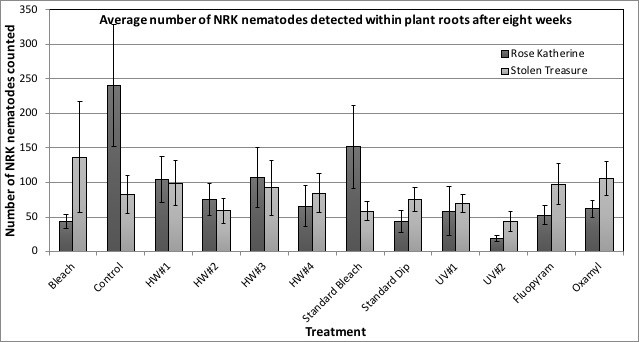Combating root-knot nematodes in daylilies: Experimental results – Part 1
New combinations of nematicides, bleach dips and ultraviolet treatments are successful in reducing the northern root knot nematode pressure on daylily rootstock.

In Part I, “Nematodes in ornamental plant production: Good or bad?” we explained that while most of the 25,000 species nematodes found in soils are beneficial, there are a few parasitic species that can cause crop losses. Northern root knot nematode, Meloidogyne hapla, is a major pest of some field-grown herbaceous perennials, such as Hemerocallis, daylilies (Fig. 1). The feeding of the nematodes causes wilting and plant stunting.
As the northern root knot nematodes feed on the roots of plants, the plants form galls that can inhibit the flow of water and nutrients within the plants, cause unsightly gall development on the roots and render the plants unmarketable in bare-root sales. There are a few common methods of suppression including fumigation, crop rotation with non-hosts (monocots or grasses), hot water dips of transplants prior to planting and nematicides. However, these treatments are not sufficient and growers are still routinely losing 20 percent of their crop.
In order to reduce or eliminate the northern root knot nematodes on the transplants, the current standard treatment is dipping the rootstock in water that is 107 degrees Fahrenheit for one hour. After the hour, they are cooled down to 55 F for half an hour. However, this method can cause up to 50 percent mortality of the propagules on some varieties. Marisol Quintanilla and Kristin Poley, Michigan State University Department of Entomology, tested a variety of treatments to test if a different water temperature, dips in bleach, Fluopyram (Indemnify from Bayer), Oxamyl (Vydate from Dow-Dupont) or ultraviolet radiation would reduce or eliminate northern root knot nematodes on rootstock (Table 1).
|
Table 1. Ten treatments performed on two cultivars of daylilies. | |
|---|---|
|
Treatment |
Description |
|
Control |
Untreated rootstock |
|
Industry standard |
1 hour at 107 F; 30 minute cool down at 55 F |
|
Hot water dip No. 1 |
50 minutes at 113 F |
|
Hot water dip No.2 |
50 minutes at 95 F |
|
Hot water dip No.3 |
30 minutes at 113 F |
|
Hot water dip No.4 |
30 minutes at 107 F |
|
Industry standard + 0.01% bleach |
1 hour at 107°F; 30 minute cool down at 55 F |
|
UV light #1 |
60 minutes under the light, flip half way through |
|
UV light #2 + submerged in water |
60 minutes under the light, flip half way through |
|
0.01% bleach dip |
4 minutes |
|
Fluopyram nematicide dip |
IR-4 2018 label recommended rate; 4 minutes |
|
Vydate nematicide dip |
At labeled rate; 4 minutes |
The 10 treatments were applied to two cultivars of daylilies, ‘Rose Katherine’ and ‘Stolen Treasure.’ Once the daylily rootstock samples had been treated, they were planted in containers and grown for eight weeks in the greenhouse. Each week, the height of the daylily was recorded. After eight weeks, the plants were removed and the roots were weighed and checked for galls. To inspect samples for galls, the roots were stained, counted and recorded.
The most effective treatments were the standard hot water dip, Fluopyram, bleach dip, UV light No. 2 treatment (Fig. 2). There was no plant mortality from the industry standard dipping procedure and approximately 6 percent mortality on average per plant cultivar for the other treatments. Therefore, with respect to plant mortality, all of these treatments were considered to be relatively safe for the rootstock.

Figure 2. The number of northern root knot nematodes on two cultivars of daylilies as a result of 12 different treatments.
Generally, the greater the nematode control, the greater the plant height and yield. There were some differences in efficacy depending on the cultivar. For example, the standard hot water plus bleach dip (soaked in 107 F water with 0.01 percent bleach) was one of the worst treatments for ‘Rose Katherine’ and had similar levels of nematode infestations to the control. However, for ‘Stolen Treasure’ that treatment had a similar efficacy to the most effective treatments, such as the standard hot water dip.
This experiment is currently being repeated during 2018 to verify the validity of the results from the first trial and to test additional combinations of the most effective treatments from 2017.
The research of Marisol Quintanilla is funded by the MDARD Horticulture Fund, the 2018 Farm Bill, private industry and the Michigan Nursery and Landscape Association.



 Print
Print Email
Email